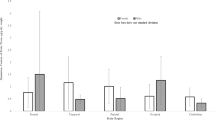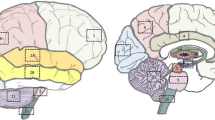Abstract
The use of inductively coupled plasma source mass spectrometry (ICP-MS) for multi-element analysis has led to the observation, in two separate studies, of increased blood tin in Alzheimer's disease (AD). We have therefore applied the technique of ICP-MS to hippocampal tissues obtained post-mortem from patients with AD and from controls. There was no significant difference in tin concentrations in AD. There were increased concentrations of aluminum and silicon, and reduced concentrations of zinc and selenium. It is postulated that displacement of hippocampal zinc by heavy metals may be important in producing clinical memory disturbance. However, analysis of the CA1 region, rather than of the dentate gyrus, would have been preferable.
Similar content being viewed by others
References
Anikstejn L, Charton B, Ben-Ari Y. 1987 Selective release of endogenous zinc from the hippocampal mossy fibers in situ. Brain Res 404, 58–64.
Candy JM, Klinowski J, Perry RH, et al. 1986 Aluminosilicates and senile plaque formation in Alzheimer's disease. Lancet i, 354–357.
Candy JM, McArthur FK, Oakley AE, et al. 1992 Aluminium accumulation in relation to senile plaque and neurofibrillary tangle formation in the brains of patients with renal failure. J Neurol Sci 107, 210–218.
Cannata JB, Fernandez-Soto I, Fernandez-Menendez MJ, et al. 1991 Role of iron metabolism in absorption and cellular uptake of aluminium. Kidney Int 39, 799–803.
Chafi AH, Hauw J-J, Rancurel G, Berry J-P, Galle C. 1991 Absence of aluminium in Alzheimer's disease brain tissue: electron microprobe and ion microprobe studies. Neurosci Lett 123, 61–64.
Constantinidis J. 1991 Hypothesis regarding amyloid and zinc in the pathogenesis of Alzheimer's disease: potential for preventive intervention. Alzheimer's Dis Associated Disorders 5, 31–35.
Corrigan FM, Reynolds GP, Ward NI. 1991a Reductions of zinc and selenium in brain in Alzheimer's disease. Trace Elem Med 8, 1–5.
Corrigan FM, Van Rhijn AG, Ijomah G, et al. 1991b Tin and fatty acids in dementia. Prostaglandins Leukotr EFAs 43, 229–238.
Corrigan FM, Crichton JS, Horrobin DF, et al. 1992 Elevated blood tin concentrations in Alzheimer's disease. Biol Psychiat 31, 749–750.
Corrigan FM, Crichton JS, Van Rhijn AG, Skinner ER, Ward NI. 1993 Transferrin, cholesterol and aluminium in Alzheimer's disease. Clin Chim Acta 211, 121–123.
Crapper DR, Krishnan SS, Dalton AJ. 1973 Brain aluminium distribution in Alzheimer's disease and experimental neurofibrillary degeneration. Science 180, 511–513.
Crawford IL, Connor JD. 1972 Zinc in maturing rat brain: hippocampal concentration and localisation. J Neurochem 19, 1451–1458.
Earley B, Biegon A, Leonard BE, 1989 Quantitative autoradiographic analysis of muscarinic recepters and quantitative histochemistry of acetyl cholinesterase in the rat brain after trimethyl tin intoxication. Neurochem Int 15, 475–483.
Ebadi M, Hama Y. 1986 Zinc-binding proteins in the brain. Adv Exp Med Biol 203, 557–570.
Ferrier IN, Leake A, Taylor GA, et al. 1990 Reduced gastrointestinal absorption of calcium in dementia. Age Ageing 19, 368–375.
Flaten TP. 1987 Geographical associations between aluminium in drinking water and dementia, Parkinson's disease and amyotrophic lateral sclerosis in Norway. Trace Elem Med 4, 179–180.
Forsythe ID, Westbrook GL, Mayer ML. 1988 Modulation of excitatory synaptic transmission by glycine and zinc in cultures of mouse hippocampal neurons. J Neurosci 8, 3733–3741.
Garruto RM, Swyt C, Fiori CE, Yanagihara R, Gajdusek DC. 1985 Intraneuronal deposition of calcium and aluminium in amyotrophic lateral sclorosis of Guam. Lancet ii, 1353.
Guy SP, Jones D, Mann DMA, Itzhaki RF. 1991 Human neuroblastoma cells treated with aluminium express an epitope associated with Alzheimer's disease neurofibrillary tangles. Neurosci Lett 121, 166–168.
Hardy J. 1992 An ‘anatomical cascade hypothesis’ for Alzheimer's disease. Trends Neurol Sci 15, 200–201.
Hesse GW. 1979 Chronic zinc deficiency alters neuronal function of hippocampal mossy fibers. Science 205, 1005–1007.
Howell GA, Welch MG, Frederickson CJ. 1984 Stimulation-induced uptake and release of zinc in hippocampal slices. Nature 308, 736–738.
Jacobs RW, Duong T, Jones RE, Trapp GA, Scheibel AB, 1989 A re-examination of aluminium in Alzheimer's disease: analysis by energy dispersive x-ray microprobe and flameless atomic absorption spectrophotometry. Can J Neurol Sci 16, 498–503.
Krishnan SS, McLachlan DR, Krishnan B, Fenton SSA, Harrison JE. 1988 Aluminium toxicity to the brain. Sci Total Environ 71, 59–64.
Landsberg JP, McDonald B, Watt, F. 1992 Absence of aluminium in neuritic plaque cores in Alzheimer's disease. Nature 360, 65–68.
Legendre P, Westbrook GL. 1990 The inhibition of single N-methyl-d-aspartate-activated channels by zinc ions on cultured rat neurons. J Physiol 429, 429–449.
Markesbery WR, Ekmann WD, Mossain TIM, Alauddin M, Goodin DT (1981) Instructive neutron activation analysis of brain aluminium in Alzheimer's disease and ageing. Ann Neurol 10, 511–516.
Martyn CN, Osmond C, Edwardson JA, Barker DJP, Harris EC, Lacey RF. 1989 Geographical relation between Alzheimer's disease and aluminium in drinking water. Lancet i, 59–62.
Muma NA, Troncoso JC, Hoffman PN, Koo EH, Price DL. 1988 Aluminium neurotoxicity: altered expression of cytoskeletal genes. Mol Brain Res 3, 115–122.
McDermott JR, Smith AI, Iqbal K, Wisniewski HM. 1979 Brain aluminium in ageing and Alzheimer's disease. Neurology 29, 809–814.
McGregor SJ, Naves ML, Oria R, Vass KJ, Brock JH. 1990 Effect of aluminium on iron uptake and transferrin-receptor expression by human erythroleukaemia K562 cells. Biochem J 272, 377–382.
McGregor SJ, Brock JH, Halls, D. 1991 The role of transferrin and citrate in cellular uptake of aluminium. Biol Metals 4, 173–175.
Peters S, Koh J, Choi DW. 1987 Zinc selectively blocks the action of N-methyl-d-aspartate on cortical neurons. Science 236, 589–593.
Petit TL, Alfano DP. 1983 Neurobiological and behavioural effects of lead. In: Dreosti IE, Smith RM, eds. Neurobiology of the Trace Elements, Vol. 2. Clifton, NJ: Humana Press.
Stewart GR, Frederickson CJ, Howell GA, Gage FH. 1984 Cholinergic denervation-induced increase of chelatable zinc in mossy-fiber region of the hippocampal formation. Brain Res 290, 43–51.
Trapp GA, Miner GD, Zimmerman RL, Mastri AR, Heston LL. 1978 Aluminium levels in brain in Alzheimer's disease. Biol Psych 13, 709–718.
Van Rhijn AG, Corrigan FM, Ward NI. 1989 Serum aluminium in senile dementia of Alzhemier's type and in multi-infarct dementia. Trace Elem Med 6, 24–26.
Van Rhijn AG, Prior CA, Corrigan FM. 1990 Dietary supplementation with zinc sulphate, sodium selenite and fatty acids in early dementia of Alzhemier's type. J Nutr Med 1, 259–266.
Ward NI, Mason JA. 1987 Neutron activation analysis techniques for identifying elemental status in Alzheimer's disease. J Radioanalyt Nucl Chem Art 113, 515–526.
Ward NI, Abou-Shakra FR, Durrant SF, Thompson J, Havercroft JM, Yadegarin L. 1991 Inductively coupled plasma mass spectrometry (ICP-MS) in biological studies for multi-element analysis and isotope ratios. In: Momcilovic B, ed. Trace Elements in Man and Animals 7 (TEMA-7). Zagreb: IMI; 33–5–33–6.
Weiss JH, Koh J-Y, Christine CW, Choi DW. 1989 Zinc and LTP. Nature 338, 212.
Wenk GL, Stemmer KL. 1983 Suboptional dietary zinc intake increase aluminium accumulation into the rat brain. Brain Res 288, 393–395.
Wenstrup D, Ehmann WD, Markesbery WR. 1990 Trace element imbalances in isolated subcellular fractions of Alzheimer disease brains. Brain Res 533, 125–131.
Westbrook GL, Mayer ML. 1987 Micromolar concentrations of Zn2+ antagonize NMDA and GABA responses of hippocampal neurons. Nature 328, 640–643.
Xie X, Smart TG. 1991 A physiological role for endogenous zinc in rat hippocampal synaptic neurotransmission. Nature 349, 521–524.
Yeh G-C, Bonhaus DW, McNamara JO. 1990 Evidence that zinc inhibits N-methyl-d-aspartate receptor-gated ion channel activation by noncompetitive antagonism of glycine binding. Mol Pharmacol 38, 14–19.
Author information
Authors and Affiliations
Rights and permissions
About this article
Cite this article
Corrigan, F.M., Reynolds, G.P. & Ward, N.I. Hippocampal tin, aluminum and zinc in Alzheimer's disease. Biometals 6, 149–154 (1993). https://doi.org/10.1007/BF00205853
Received:
Accepted:
Issue Date:
DOI: https://doi.org/10.1007/BF00205853




